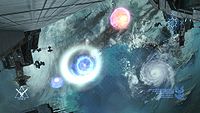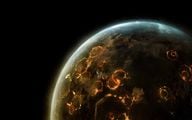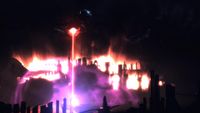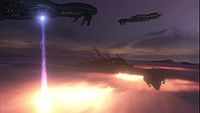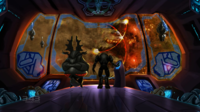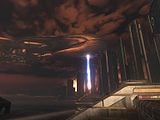Glassing: Difference between revisions
From Halopedia, the Halo wiki
(→Trivia) |
|||
| Line 93: | Line 93: | ||
==Trivia== | ==Trivia== | ||
*It has been noted that UNSC territory encompassed over eight-hundred colonies at the beginning of the Human-Covenant War, most of which were glassed by the Covenant.<ref>'''[[Halo Encyclopedia]]''', "chapter 1", ''page 33''</ref><ref>[http://web.archive.org/web/20080424150226/www.xbox.com/en-US/games/h/halo/storyline.htm '''Xbox.com''': ''The Halo Timeline'']</ref> | *It has been noted that UNSC territory encompassed over eight-hundred colonies at the beginning of the Human-Covenant War, most of which were glassed by the Covenant.<ref>'''[[Halo Encyclopedia]]''', "chapter 1", ''page 33''</ref><ref>[http://web.archive.org/web/20080424150226/www.xbox.com/en-US/games/h/halo/storyline.htm '''Xbox.com''': ''The Halo Timeline'']</ref> | ||
*Though glassing was previously thought to be permanent, it is possible through [[terraforming]] to reclaim the environment of a glassed planet | *Though glassing was previously thought to be permanent, it is possible through [[terraforming]] to reclaim the environment of a glassed planet. Reach was shown to have taken at least 37 years to recover. | ||
*Occasionally | *Occasionally, glassing occurs in areas where Covenant ground troops are still present. This was seen at both the events at [[Kholo]] and [[Reach]].<ref>'''[[Halo: Reach]]''', campaign level, ''[[The Pillar of Autumn (Halo: Reach level)]]''</ref><ref>'''[[Halo: Evolutions - Essential Tales of the Halo Universe]]''', ''[[The Return]]''</ref> | ||
==Gallery== | ==Gallery== | ||
Revision as of 18:09, February 25, 2011
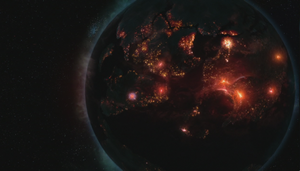
- "You are...all of you...vermin. Cowering in the dirt thinking... what, I wonder? That you might escape the coming fire? No. Your world will burn until its surface is but glass!"
- — Prophet of Truth
The term glassing, also known as plasma bombardment[1], is used to refer to the act by which a Covenant ship or ships bombard a planet from orbit using heavy plasma weaponry.
Doctrine
The process of glassing a planet begins when a fleet has achieved air and space superiority on an enemy controlled world. The specifics of the glassing process vary depending on the strategic significance of the planet or the orders of the Fleet Master. A Minor Prophet is assigned to most Covenant fleets to oversee the destruction of a human world. In certain or possibly all instances, before the fleet is permitted to destroy a planet, the Prophet performs a religious ritual - the Prophet declares by which religious ideal of the Covenant, marked by a glyph, will the world be destroyed. There is currently only one known instance of a human world having a glyph burned into its surface.[2] Any ground operations cease and local forces are evacuated, the Covenant will then begin glassing the planet from orbit by moving their large warships closer together and blanket the world with a series of crisscrossing orbits to ensure that every square millimeter of the surface is destroyed.[1] The glassing of a planet by the Covenant is a very taxing process, and requires a massive amount of energy even for the Covenant.[3] Nevertheless, the Covenant are able to accomplish this feat in an effective matter.
Throughout the war, the Covenant have been known to utilize two methods of glassing:
Orbital bombardment
Typically when fleet actions require no deployment of ground forces for any particular reason, the Covenant will glass the planet from orbit, this is accomplished by their larger warships gathering close together, aiming their plasma batteries, located along the lateral lines of their warships towards the surface and fire them.[4] Once discharged, the plasma rounds are guided towards the surface, contained in a magnetic bubble and controlled by the ships automation through miles of atmospheric interference until it strikes its intended target. Described as looking like a fireball in appearance,[5] these plasma lances are a hundred meters across,[5] and strike the surface with tremendous speed and force.
The impact of the plasma lance or bolt, is similar to that of a nuclear detonation on a much different scale. When the plasma bolt impacts the surface, the magnetic field sustaining and guiding the plasma collapses, and, depending on how powerful the release of energy is, the initial zone of impact is obliterated instantly. The areas outside of the initial impact zone are affected by the heat wave generated by the blast; depending on the range, those closest outside of the blast zone are instantly killed by the intense heat. As thermal expansion takes over, the resulting flames fan out and create a pyroclastic surge,[6] which will continue to burn the areas it comes into contact with until it has cooled enough that it cannot harm the surface.
The top soil in the impact zone and other surface geology, is molten and converted into a mineral called lechatelierite that is similar to glass.[7][8] The surrounding areas are blasted with intense heat and is burned.[7]
Subsequently, the atmosphere is saturated with millions of tons of ash, debris and soot that are thrown up from the initial impact, blocking sunlight and dramatically lowering the amount of sunlight reaching the planets surface, subjecting it to an impact winter. As the ground zero area cools, the surface is covered by extensive areas of molten soil, and is comparable to active volcanic sites in some parts of the world, on a larger scale.
Low-range bombardment
When ground engagements are in effect the Covenant will result to low range bombardment, bringing their ships closer to the surface and destroy an area in question. This is accomplished by either building up or focusing plasma though a magnetic envelope from the energy projector located on the underside of the ship, and then discharging the plasma as a narrow beam. A single Covenant capital ship can glass approximately one acre of a planet's surface in fifteen seconds of sustained fire.[9] The Covenant use low range bombardment in many battles where major ground engagement are occurring, smaller warships will use this method specifically to deal with human armies and low level structures during campaigns, while larger Covenant warships use this to level cities while engagements are occurring.
Low range bombardment isn't limited to energy projectors; lower class Covenant ships like the corvette are equipped with bombardment guns[10] that fire smaller less powerful lances then that fired from their capital ships. Capital ships can also use their energy projector for excavate areas of interest for the Covenant, such as unearthing the portal to the the Ark during the Battle of Earth.
Aftermath
The destructive process of bombarding the surface of a planet with plasma leaves the surface unable to recover to its former state without re-terraforming. During the glassing of a planet the Covenant focus on destroying the ecosystem of a planet, and will spend a considerable amount of time vaporizing any bodies of water the planet may possess, or at least reduces the remaining water to small, ash-choked pools. The deeper the bodies of water is the more time it will take to vaporize it.[9] Once the Covenant have finished the surface is dead, devoid of any life on the surface. From orbit the world is simply a series of grays, blacks and reds,[11] everything on the surface is charred and the air is littered with ash and dust.
Glassing a planet can take a great deal of time dependent upon both the tonnage and class of the Covenant vessel and how many ships are within the fleet. In either case the planet in question could be glassed in a minimum of two days,[12] or two weeks,[13] or longer to completely burn the surface of a planet.
It is possible for the atmosphere of a planet to boil away or more correctly suffer atmospheric escape from the process.[14] Large planets, particularly those of which the damage is not enough for it to lose atmospheric gases to space, do not suffer this.
Because of the extensive destruction brought by the Covenant, the only way the world could recover is by re-terraforming efforts. The undertaking of such an effort would be massive and time consuming, ranging from a conservative one hundred and ten years to over three hundred years given the manpower and technology at the time of such estimates.[15] It is possible that with the advent discovery of Forerunner technology and absorption of knowledge, humanity's ability to rebuild glassed planets take less time with the knowledge learned, as Reach was shown to take a mere thirty-seven years to at least partially recover.[16]
Throughout the war, areas of interest to the Covenant are left intact for reasons of study or retrieval; however, this is not common, as only a handful of planets have been partially glassed and only when a Forerunner Artifact was discovered.[17] After the Covenant glasses a planet, a shard of glass is removed and placed in the Sanctum of the Hierarchs within High Charity.[18]
History
Since the formation of the Covenant in 852 BCE the Covenant have used their ship-borne plasma weapons to threaten the lesser species of the Covenant into a truce and their eventual induction into the Covenant. The Lekgolo were the first to be threatened with such destruction because of their transgressions against Forerunner technology before becoming the first outside species to join the Covenant in 784 BCE.[19][20] The Unggoy almost faced orbital bombardment for their Rebellion in 2462 CE, or the 39th Age of Conflict by Covenant records.[21][22] Although the Kig-Yar were not threatened with orbital bombardment, they were quick to realize the Covenant had such a capacity to destroy them and thus chose to join the Covenant for greater wealth that the Covenant would provide.
Human-Covenant War
- Main article: Human-Covenant War
After the Prophets declaration to wipe out humanity, the Covenant would put all of their destructive methods to use. The first planet to suffer this fate was Harvest, glassed from the Jiralhanae-operated cruiser Rapid Conversion.[23]
By the time Admiral Preston Cole arrived with his battlegroup in March of 2526 the Covenant had nearly destroyed the whole planet, after Cole's bloody victory the UNSC had declared the colony lost with no real way to make use of the planet.
The term "glassing" was coined by the UN military think tank group Assembly that same year. The group at the time estimated that it would take 30.3801 years for a Covenant fleet of comparable size to that of the UNSC's to literally turn the entire surface of Earth to glass relying on the available facts. The Assembly chose the term magnify the horrible act and hoped it galvanize humanity into action.[9]
Throughout the rest of 2525 and 2526, the Covenant continued their campaigns in the Outer Colonies glassing a number of worlds and human establishments including Biko, Green Hills, and Bliss. Admiral Cole and his fleet continued fighting for these colonies but they were lost causes, the Covenant with their firepower and determination continued their ruthless campaign until the last outer colony was glassed in 2535. Each battle human forces face with the Covenant were brutal ground forces were often deployed first, but as UNSC forces were routed in space, the bombardment would commence resulting in either loss of life or retreat.[24]
Their bloody campaign continued as the Covenant moved into the inner colonies and began glassing major worlds, throughout the 2540s the UNSC continued their attempts at slowing the Covenant down, and although some of these tactics succeeded the covenant continued to swarm human controlled space glassing every world they found. After the believed death of Admiral Cole in 2543 the Covenant for a brief period of time halted and renewed their bloody tenacity and attacked human controlled worlds with even more ferocity. After the Fall of Reach in August of 2552 the Covenant leadership believed humanity would lose the will to fight[25] however the loss of Reach caused humanity to fight to the last breath eventually achieving victory and ending the war.
The Battle of Earth culminated in the glassing of the city of Voi in Africa by Covenant Separatists, in an effort to contain a Flood infestation which had come to Earth only hours earlier.[26] Lord Hood accused Rtas 'Vadum and the Sangheili lead fleet of glassing half of the continent, but given his distaste for his former enemies, he might have exaggerated about the actual extent of the glassing.
Halo Wars
- Main article: Halo Wars
In Halo Wars, the Prophet of Regret faction of the Covenant are able to use the Prophet to call down a Cleansing Beam from an orbiting Covenant ship. Rather than a leader power, this is treated as the unit's secondary ability, using the Y button to guide the beam at the cost of resources every second. It lacks the power of typical glassing maneuvers seen in past canon to balance gameplay much like Captain Cutter's ability to fire a MAC blast at enemy targets.
List of known glassed worlds
Trivia
- It has been noted that UNSC territory encompassed over eight-hundred colonies at the beginning of the Human-Covenant War, most of which were glassed by the Covenant.[27][28]
- Though glassing was previously thought to be permanent, it is possible through terraforming to reclaim the environment of a glassed planet. Reach was shown to have taken at least 37 years to recover.
- Occasionally, glassing occurs in areas where Covenant ground troops are still present. This was seen at both the events at Kholo and Reach.[29][30]
Gallery
- ReachConcept - FoR.jpg
The surface of Reach after being glassed.
- 7inTheSky.png
A orbital lance strikes Reach's surface.
A CCS-class Battlecruiser glassing New Alexandria.
Two CCS-class Battlecruisers perform a low range glassing of Voi.
- Kholo.png
Covenant ships glassing Kholo.
A Shipmaster during the ritual destruction of Kholo, overseen by a Prophet.
- HW genis back cover.png
Three Covenant Destroyers glassing Harvest.
List of appearances
- Halo 2
- Halo 3
- Halo 3: ODST
- Halo Wars
- Halo: Reach
- Halo: The Fall of Reach (First appearance)
- Halo: First Strike
- Halo: Ghosts of Onyx
- Halo: Contact Harvest
- Halo: The Cole Protocol
- Halo: Evolutions - Essential Tales of the Halo Universe
- Halo Legends
Notes
Sources
- ^ a b Halo: First Strike, page 105 page 136 2010 edition
- ^ Halo: Evolutions, "The Return", pages 494-496
- ^ Halo: Evolutions, "The Return", page 495
- ^ Halo: The Fall of Reach, page 8 page 22 2010 edition
- ^ a b Halo: First Strike page 32 page 46 2010 edition
- ^ Pyroclastic Surge on Wikipedia
- ^ a b Halo: Evolutions, "The Return", page 505
- ^ Lechatelierite on Wikipedia
- ^ a b c Halo: Reach, Data pad 10
- ^ Brandy Games Halo: Reach Legendary Edition Guide page 440
- ^ Halo: First Strike Bonus Content page 417
- ^ Halo Legends (2010), Bonus Feature Halo: The Story So Far
- ^ Halo: The Fall of Reach, Bonus Content page 389
- ^ Halo: The Fall of Reach, page 8 page 23 2010 edition
- ^ Halo: Reach, Data pad 14
- ^ Halo: Reach, campaign level Lone Wolf
- ^ Halo: First Strike page 122 page 150 2010 edition
- ^ Halo: First Strike page 338 page 405 2010 edition
- ^ Halo: Contact Harvest page 270
- ^ Halo Encyclopedia page 114
- ^ Halo: Contact Harvest, page 151
- ^ Halo Encyclopedia page 142
- ^ Halo: Contact Harvest page 285
- ^ Halo: The Fall of Reach page 173 page 199 2010 edition
- ^ Halo: Evolutions, "The Return", page 499
- ^ Halo 3, campaign level, Floodgate
- ^ Halo Encyclopedia, "chapter 1", page 33
- ^ Xbox.com: The Halo Timeline
- ^ Halo: Reach, campaign level, The Pillar of Autumn (Halo: Reach level)
- ^ Halo: Evolutions - Essential Tales of the Halo Universe, The Return
